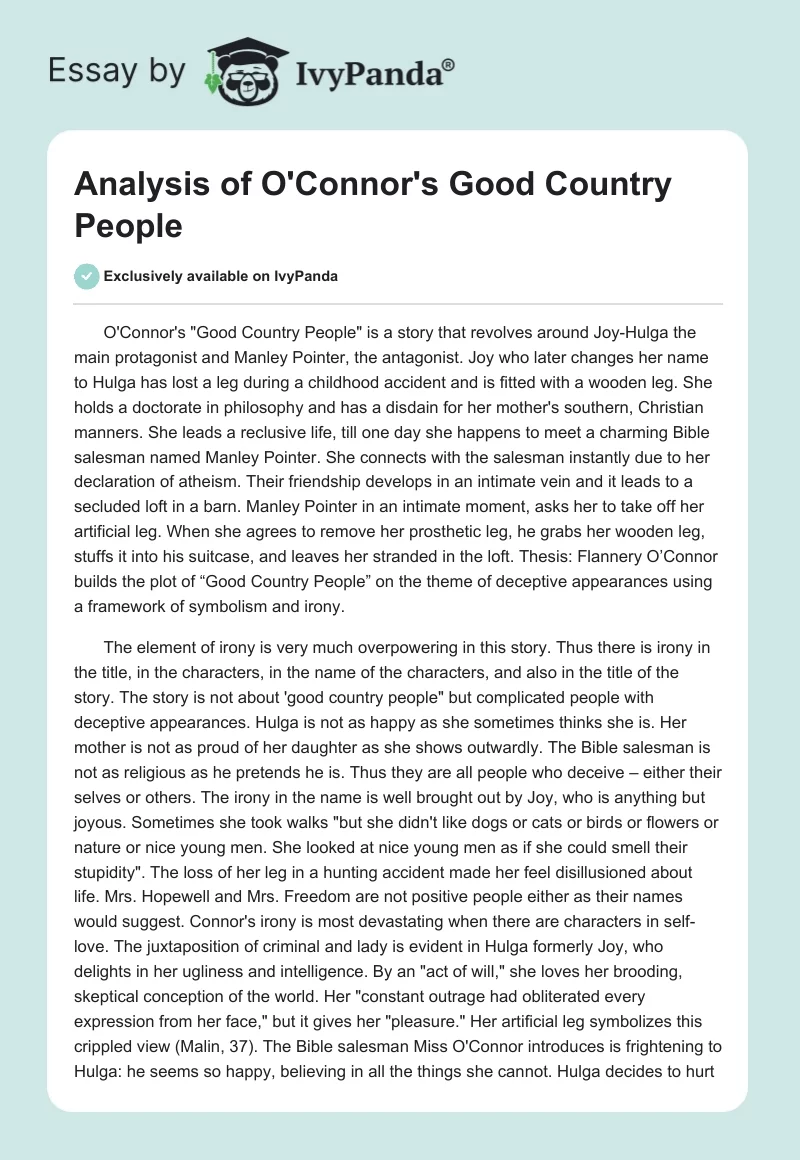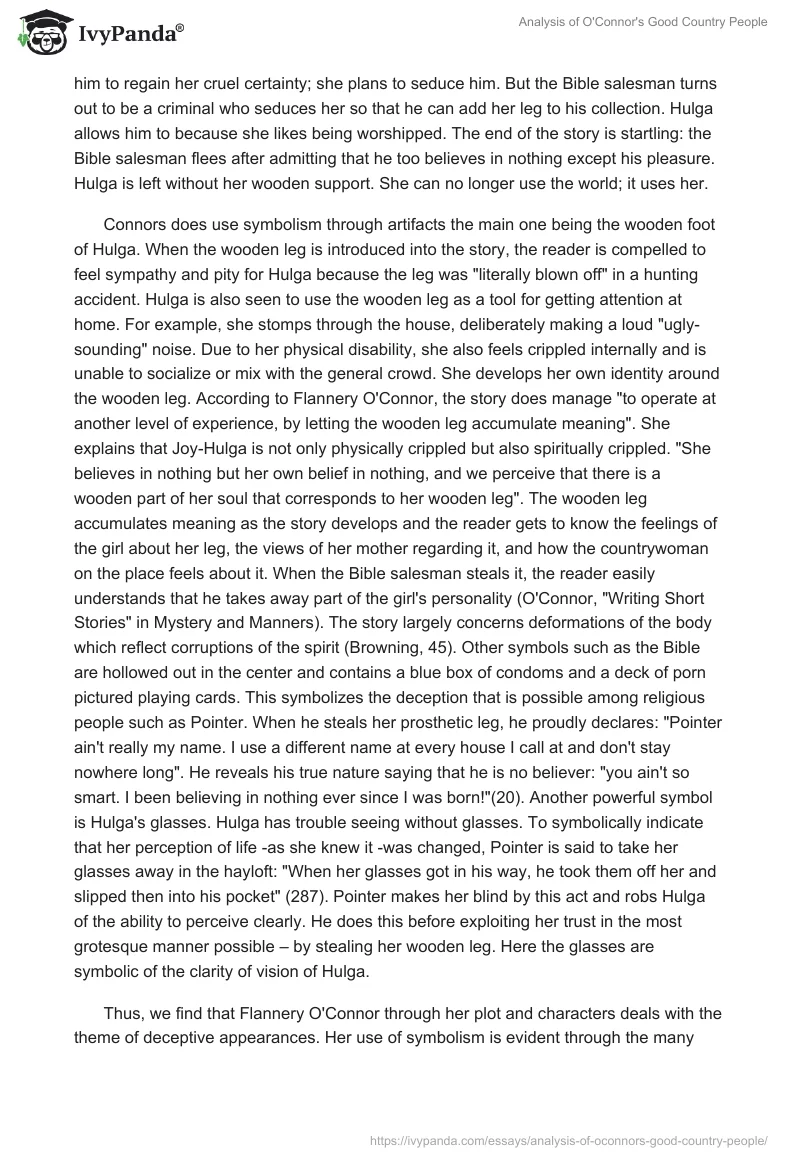O’Connor’s “Good Country People” is a story that revolves around Joy-Hulga the main protagonist and Manley Pointer, the antagonist. Joy who later changes her name to Hulga has lost a leg during a childhood accident and is fitted with a wooden leg. She holds a doctorate in philosophy and has a disdain for her mother’s southern, Christian manners. She leads a reclusive life, till one day she happens to meet a charming Bible salesman named Manley Pointer. She connects with the salesman instantly due to her declaration of atheism. Their friendship develops in an intimate vein and it leads to a secluded loft in a barn. Manley Pointer in an intimate moment, asks her to take off her artificial leg. When she agrees to remove her prosthetic leg, he grabs her wooden leg, stuffs it into his suitcase, and leaves her stranded in the loft. Thesis: Flannery O’Connor builds the plot of “Good Country People” on the theme of deceptive appearances using a framework of symbolism and irony.
The element of irony is very much overpowering in this story. Thus there is irony in the title, in the characters, in the name of the characters, and also in the title of the story. The story is not about ‘good country people” but complicated people with deceptive appearances. Hulga is not as happy as she sometimes thinks she is. Her mother is not as proud of her daughter as she shows outwardly. The Bible salesman is not as religious as he pretends he is. Thus they are all people who deceive – either their selves or others. The irony in the name is well brought out by Joy, who is anything but joyous. Sometimes she took walks “but she didn’t like dogs or cats or birds or flowers or nature or nice young men. She looked at nice young men as if she could smell their stupidity”. The loss of her leg in a hunting accident made her feel disillusioned about life. Mrs. Hopewell and Mrs. Freedom are not positive people either as their names would suggest. Connor’s irony is most devastating when there are characters in self-love. The juxtaposition of criminal and lady is evident in Hulga formerly Joy, who delights in her ugliness and intelligence. By an “act of will,” she loves her brooding, skeptical conception of the world. Her “constant outrage had obliterated every expression from her face,” but it gives her “pleasure.” Her artificial leg symbolizes this crippled view (Malin, 37). The Bible salesman Miss O’Connor introduces is frightening to Hulga: he seems so happy, believing in all the things she cannot. Hulga decides to hurt him to regain her cruel certainty; she plans to seduce him. But the Bible salesman turns out to be a criminal who seduces her so that he can add her leg to his collection. Hulga allows him to because she likes being worshipped. The end of the story is startling: the Bible salesman flees after admitting that he too believes in nothing except his pleasure. Hulga is left without her wooden support. She can no longer use the world; it uses her.
Connors does use symbolism through artifacts the main one being the wooden foot of Hulga. When the wooden leg is introduced into the story, the reader is compelled to feel sympathy and pity for Hulga because the leg was “literally blown off” in a hunting accident. Hulga is also seen to use the wooden leg as a tool for getting attention at home. For example, she stomps through the house, deliberately making a loud “ugly-sounding” noise. Due to her physical disability, she also feels crippled internally and is unable to socialize or mix with the general crowd. She develops her own identity around the wooden leg. According to Flannery O’Connor, the story does manage “to operate at another level of experience, by letting the wooden leg accumulate meaning”. She explains that Joy-Hulga is not only physically crippled but also spiritually crippled. “She believes in nothing but her own belief in nothing, and we perceive that there is a wooden part of her soul that corresponds to her wooden leg”. The wooden leg accumulates meaning as the story develops and the reader gets to know the feelings of the girl about her leg, the views of her mother regarding it, and how the countrywoman on the place feels about it. When the Bible salesman steals it, the reader easily understands that he takes away part of the girl’s personality (O’Connor, “Writing Short Stories” in Mystery and Manners). The story largely concerns deformations of the body which reflect corruptions of the spirit (Browning, 45). Other symbols such as the Bible are hollowed out in the center and contains a blue box of condoms and a deck of porn pictured playing cards. This symbolizes the deception that is possible among religious people such as Pointer. When he steals her prosthetic leg, he proudly declares: “Pointer ain’t really my name. I use a different name at every house I call at and don’t stay nowhere long”. He reveals his true nature saying that he is no believer: “you ain’t so smart. I been believing in nothing ever since I was born!”(20). Another powerful symbol is Hulga’s glasses. Hulga has trouble seeing without glasses. To symbolically indicate that her perception of life -as she knew it -was changed, Pointer is said to take her glasses away in the hayloft: “When her glasses got in his way, he took them off her and slipped then into his pocket” (287). Pointer makes her blind by this act and robs Hulga of the ability to perceive clearly. He does this before exploiting her trust in the most grotesque manner possible – by stealing her wooden leg. Here the glasses are symbolic of the clarity of vision of Hulga.
Thus, we find that Flannery O’Connor through her plot and characters deals with the theme of deceptive appearances. Her use of symbolism is evident through the many artifacts whereas irony permeates through the title, the names of characters, the plot, and the complex characters themselves.
Works Cited
O’Connor, Flannery (1971). The Complete Short Stories. New York: Farrar.
Malin, Irving (1962). New American Gothic. Southern Illinois University Press. Carbondale.
Browning, M. Preston Jr. (1974). Flannery O’Connor. Southern Illinois University Press. Carbondale, IL.


